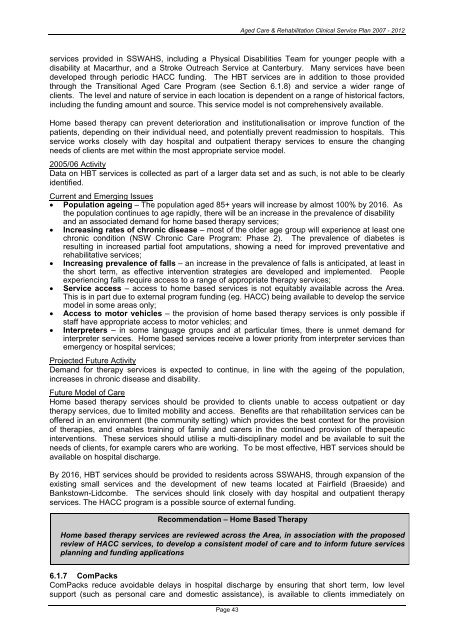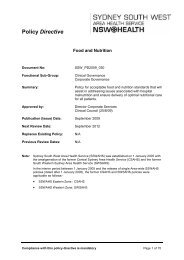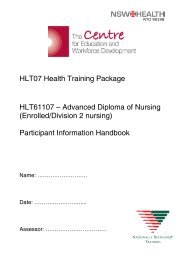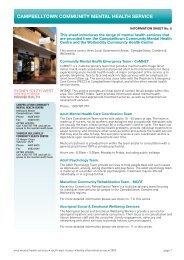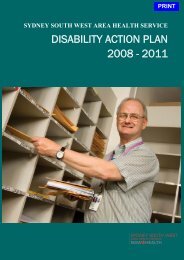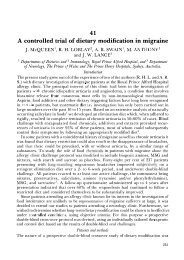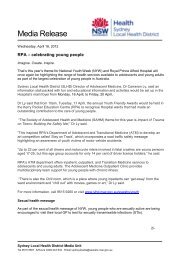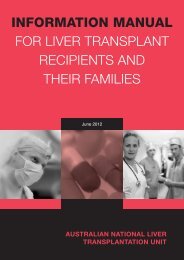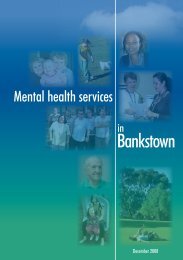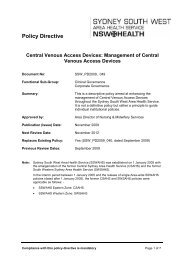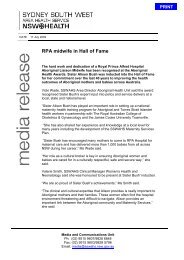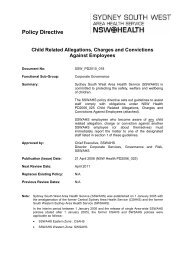Aged Care & Rehabilitation Clinical Services Plan 2007 – 2012
Aged Care & Rehabilitation Clinical Services Plan 2007 – 2012
Aged Care & Rehabilitation Clinical Services Plan 2007 – 2012
You also want an ePaper? Increase the reach of your titles
YUMPU automatically turns print PDFs into web optimized ePapers that Google loves.
<strong>Aged</strong> <strong>Care</strong> & <strong>Rehabilitation</strong> <strong>Clinical</strong> Service <strong>Plan</strong> <strong>2007</strong> - <strong>2012</strong>services provided in SSWAHS, including a Physical Disabilities Team for younger people with adisability at Macarthur, and a Stroke Outreach Service at Canterbury. Many services have beendeveloped through periodic HACC funding. The HBT services are in addition to those providedthrough the Transitional <strong>Aged</strong> <strong>Care</strong> Program (see Section 6.1.8) and service a wider range ofclients. The level and nature of service in each location is dependent on a range of historical factors,including the funding amount and source. This service model is not comprehensively available.Home based therapy can prevent deterioration and institutionalisation or improve function of thepatients, depending on their individual need, and potentially prevent readmission to hospitals. Thisservice works closely with day hospital and outpatient therapy services to ensure the changingneeds of clients are met within the most appropriate service model.2005/06 ActivityData on HBT services is collected as part of a larger data set and as such, is not able to be clearlyidentified.Current and Emerging Issues• Population ageing – The population aged 85+ years will increase by almost 100% by 2016. Asthe population continues to age rapidly, there will be an increase in the prevalence of disabilityand an associated demand for home based therapy services;• Increasing rates of chronic disease – most of the older age group will experience at least onechronic condition (NSW Chronic <strong>Care</strong> Program: Phase 2). The prevalence of diabetes isresulting in increased partial foot amputations, showing a need for improved preventative andrehabilitative services;• Increasing prevalence of falls – an increase in the prevalence of falls is anticipated, at least inthe short term, as effective intervention strategies are developed and implemented. Peopleexperiencing falls require access to a range of appropriate therapy services;• Service access – access to home based services is not equitably available across the Area.This is in part due to external program funding (eg. HACC) being available to develop the servicemodel in some areas only;• Access to motor vehicles – the provision of home based therapy services is only possible ifstaff have appropriate access to motor vehicles; and• Interpreters – in some language groups and at particular times, there is unmet demand forinterpreter services. Home based services receive a lower priority from interpreter services thanemergency or hospital services;Projected Future ActivityDemand for therapy services is expected to continue, in line with the ageing of the population,increases in chronic disease and disability.Future Model of <strong>Care</strong>Home based therapy services should be provided to clients unable to access outpatient or daytherapy services, due to limited mobility and access. Benefits are that rehabilitation services can beoffered in an environment (the community setting) which provides the best context for the provisionof therapies, and enables training of family and carers in the continued provision of therapeuticinterventions. These services should utilise a multi-disciplinary model and be available to suit theneeds of clients, for example carers who are working. To be most effective, HBT services should beavailable on hospital discharge.By 2016, HBT services should be provided to residents across SSWAHS, through expansion of theexisting small services and the development of new teams located at Fairfield (Braeside) andBankstown-Lidcombe. The services should link closely with day hospital and outpatient therapyservices. The HACC program is a possible source of external funding.Recommendation – Home Based TherapyHome based therapy services are reviewed across the Area, in association with the proposedreview of HACC services, to develop a consistent model of care and to inform future servicesplanning and funding applications6.1.7 ComPacksComPacks reduce avoidable delays in hospital discharge by ensuring that short term, low levelsupport (such as personal care and domestic assistance), is available to clients immediately onPage 43


